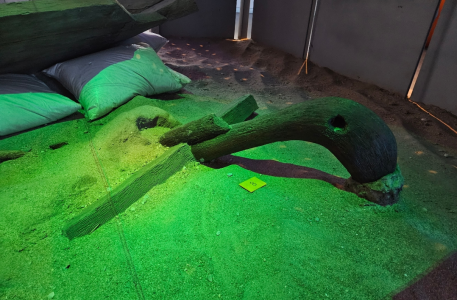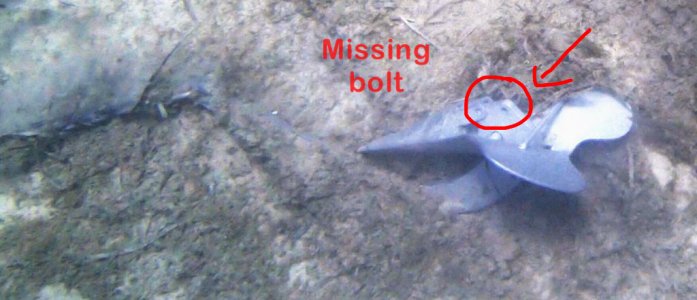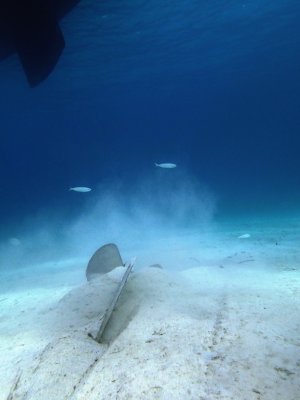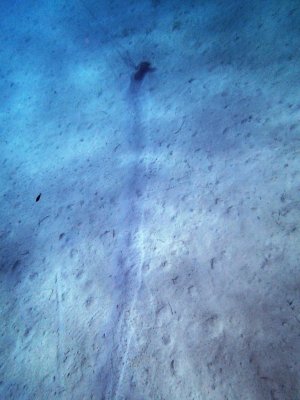Ray Purchase
Well-Known Member
Is this how you do it?
Aren't we all....?I see you are very gradually working your way up the anchor performance scale.
Is this how you do it?
I always used an anchor with a mooring weight. Otherwise there is a risk of the weight being steadily bounced along the bottom due to wind/wave action on the boat. Unless the mooring weight is in sticky mud that will slowly absorb it with the suction making it almost impossible to lift.Facebook has just sent me this, no idea why!
View attachment 182903
As Indy would say: it belongs to a museum!View attachment 182923
How about this one?

Perhaps we should call that class the 'Yorkshire Anchor'....An interesting metric - one I've never seen calculated arithmetically but many of us estimate roughly in our heads - is holding power per £1 or $1 spent on buying the anchor.
This is why those of us that don't need maximum theoretical holding power for a particular sixe of anchor whatever the cost bimble along very happily with any old anchor that works OK for us.
By this metric an old concrete block rescued from a skip has a factor of near infinity, far better than any Rocna or Epsilon or NewFangler Mk V. Because its holding power of b* all divided by the 50p given to your 7 year old son to help you carry it home is a very big number indeed. I'm not advocating a concrete block, but I think this is one of the reasons people end up using a bundle of rebar or a 70 year old Danforth with bent flukes.
As Indy would say: it belongs to a museum!
View attachment 182925
(Again a Roman anchor, from Cartagena museum of maritime archaeology)
Could be lift bags (not a good anchor!). I think that was a demonstration on how they salvage these wrecks.Are those pillows? The sea bed, I presume.
That reminds me. A few years ago a couple of guys I worked with were trying to lower a go pro to check something. They looked around the workboat for the biggest, heaviest object they could find, and chose the 'priest'- a stout plastic rod, similar in size to a rolling pin, used for killing fish. They spent an inordinate length of time tying it to the go-pro, before proudly committing the whole lot to the deep, trusted to a spool of twine.The worst anchor is one that floats

Another vote:
A Kobra (Mk2) with a missing bolt.
The Kobra is not a terrible anchor, being slightly better than the Delta in my view. It does not deserve to be in the worst anchor category. But check the locking bolt. It lies under the anchor so it is difficult to inspect from the boat.
When sitting on the bow roller, the anchor and fluke hang in the normal position even with the bolt is missing so the problem is not obvious. If the bolt works loose the anchor does not work. It even seems to balance with the fluke above the substrate where the holding power is non existent (see the underwater photo that I took after the anchor had dragged hundreds of metres).
This yachtsman anchored multiple times, but dragged on each occasion. I was intrigued to see what was the problem so I dived to see why the Kobra would not set.
It was obvious underwater that the bolt retaining the fluke at correct orientation was missing. It took some time before I could convince the skipper of the real problem (we did not share a common language), but eventually he understood and replaced the bolt and the anchor set normally.
Check the bolt or bolts on your Kobra, Spade, Mantus or Viking anchor occasionally especially if the nut or nuts are hidden under the fluke and it is a single bolt, as it is on some designs. This will avoid your anchor qualifying in the worst anchor category. Especially if I am around to document the mistake.
View attachment 182941


Though the photography is stunning I do not believe that this is typical. Good and opportunistic photography does not a bad anchor make. There are members here and respected members (so that excludes me
You could explore 'The Midl Of Lidl' near you, as the stores often have fitness kit, quite cheap, that would seem to fit the description exactly.I used to have a small, plastic coated, mushroom anchor weighing about 5lb.... the plastic coating wouldn't damage the fabric.
If I could find another one I'd get it
Almost the only failure to set experienced by one of our Deltas was immediately outside Pwllheli marina. This is basically a surf beach, very hard packed sand. The anchor utterly refused to set in numerous attempts, just dragging over the surface.Another dismal anchor performance that I have observed.
This was a Delta anchor that managed to drag despite a long scope (7:1 ) and minimal average wind (20-25k). The puffs of sand show the anchor is moving in the gusts when the photograph was taken. That is our keel above the anchor. The anchor was under our boat at this stage.
The long mark in the second photograph shows part of the distance that this anchor had slowly dragged without being able to dig into the substrate.
The problem was the hard sand substrate that the Delta was unable to adequately penetrate.
Maybe not the worst anchor performance in history (the drag was only slow), but perhaps a good indication that this anchor does have limitations in less than ideal substrates.
View attachment 182958
View attachment 182959
But a Delta not setting is much more news worthy than a Delta anchor that is boringly well set and consistently reliable.Almost the only failure to set experienced by one of our Deltas was immediately outside Pwllheli marina. This is basically a surf beach, very hard packed sand. The anchor utterly refused to set in numerous attempts, just dragging over the surface.
Another dismal anchor performance that I have observed.
This was a Delta anchor that managed to drag despite a long scope (7:1 ) and minimal average wind (20-25k). The puffs of sand show the anchor is moving in the gusts when the photograph was taken. That is our keel above the anchor. The anchor was under our boat at this stage.
The long mark in the second photograph shows part of the distance that this anchor had slowly dragged without being able to dig into the substrate.
The problem was the hard sand substrate that the Delta was unable to adequately penetrate.
Maybe not the worst anchor performance in history (the drag was only slow), but perhaps a good indication that this anchor does have limitations in less than ideal substrates.
View attachment 182958
View attachment 182959